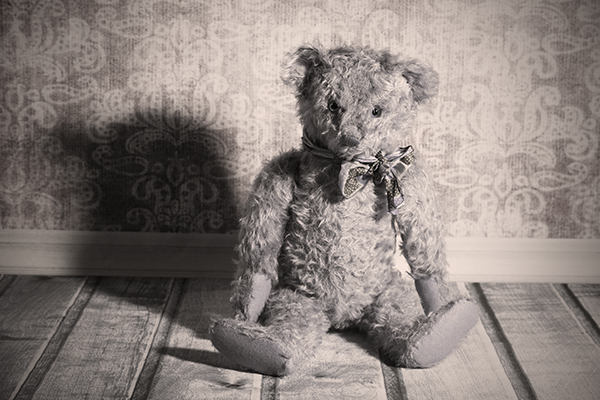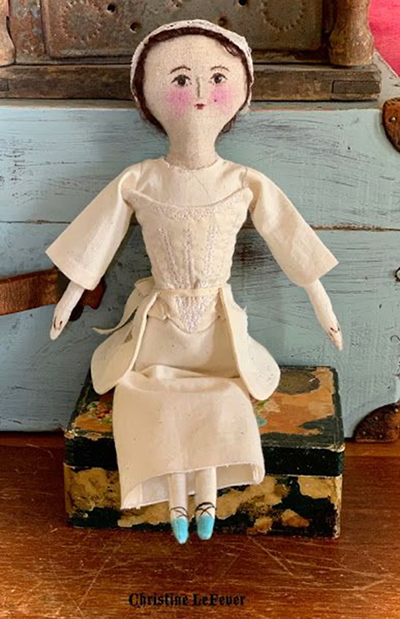
While I did all of the initial research for my Beneath the Alders series and for the first book in the series, The Innocent, I was greatly assisted in completing The Beleaguered and The Mending by the research skills of my good friend Colleen Mahoney, a pre-maturely retired librarian. For this newsletter, I asked Colleen questions about dolls in the early 20th century.
Lynne: The movie Barbie begins with little girls playing with dolls that existed pre-Barbie. What kind of dolls would have been popular in the early 1900s when Jessie was a child?
Colleen: Good question. It was likely one of two types. The first type being a simple cloth/rag doll. While the familiar Raggedy Ann doll was first introduced to the world when her creator Johnny Gruelle patented that doll in 1915, there were plenty of cloth dolls on the market prior to that date.
The second type of doll would have been made with a “bisque” head (more about this term later) and likely of the baby doll variety. Society encouraged girls to play with baby dolls as a way of preparing them for motherhood. Playing with and caring for baby dolls were seen as ways to help develop maternal instincts.
Fun fact: When Teddy bears became all the rage in about 1906, and both boys and girls were clamouring for them, some religious leaders feared that the replacement of baby dolls with bear dolls would extinguish little girls’ maternal instincts.

Lynne: Interesting! But getting back to human dolls, what can you tell us about baby dolls and rag dolls? What did they look like?
Colleen: To help answer this, I focused much of my research on advertisements in the Toronto Daily Star (now the Toronto Star). The Robert Simpson Company, which later became Simpsons, advertised toys and dolls heavily around the Christmas period. The advisements listed, in varying detail, all of the toys on sale that day. (Sadly, there were no accompanying photos in the newspaper.) The vast majority of descriptions were for baby dolls, but a couple featured more grown-up dolls and cloth/rags dolls.
In comparison to the descriptions of bisque dolls below, the lowly rag doll didn’t get much hype. Example 1: “Rag Dolls. Regular 20c. Thursday 10c.” Example 2: “Bye-Bye Kids. A well-made rag doll. Regular $1.00 Thursday 59c.”
To supplement this, I can tell you that cloth/rag dolls were being mass produced by the late 1800s, and rather than being put together from clothing scraps found around the house, they were being made from sturdy fabrics, cut, stitched and stuffed. Doll’s clothing would consist of dresses, using anything from silks to velvet to cotton. Their faces would have either been painted on with oil paints or the features stitched into the fabric. Human hair or mohair would be added to complete the look. As a general rule, rag/cloth dolls were less expensive that other types of dolls.
I found the story of Dean’s Rag Book Company interesting as it pertains to rag dolls.
Dean`s Rag Book Company was publishing company founded in the early 1900s on the strength of its newly patented rag book. Exactly as it sounds, the book’s pages were comprised of cloth instead of paper. The idea behind it was that a book of cloth would be practically indestructible no matter kind of punishment a kid could dream up for it. He or she could chew on it, throw it in the mud puddle, let it be mauled by the family dog even and it could be washed like any other cloth item and be practically as good as new. With the popularity of the books, it didn’t take long for the publisher to realize they were on to something big. If you can print on cloth why not expand the process to rag toys that could also be thrown into the wash. This led to a line of rag toys called Knock-About-Toys. The first of these were sew-it-yourself cloth panels that could be cut, stuffed and sewn into dolls of varying models (for example, a Red Riding Hood doll). Before long, Dean’s got into the toy manufacturing business and started making all sorts of ready-made toys. One of these was a two-foot-tall rag doll which would fit the clothes of a two-year-old.
Here's a photo of a couple of Knock-About dolls.

Lynne: And baby dolls? What did they look like?
Colleen: Here’s a typical advertisement for a baby doll. “Baby Doll, standing 14 inches high, and showing his two first teeth just cut; legs and arms are jointed, and doll can be made to sit; head can be turned as wanted; natural-looking expression and natural-looking limbs. Special each for… $1.25.”
Another: “Baby Dolls, thousands of Baby Dolls, with jointed legs and arms; and moveable head, muslin dress, ribbon trimmed, beautiful expression. Stands 11 inches high; doll has just cut two front teeth. Special, each, for … 98 cents.”
The price would vary according to size and, I’m assuming, quality.
In terms of the more grown-up dolls, the following was my favourite description… “My Darling (its name I’m guessing), with beautiful head of curls; eyes to open and sleep, scion wig, bisque head, with the use of jointed legs and arms; doll will stand 22 inches in height, has lace stockings, patent slippers and buckle…. Special price Monday $1.00.”
Lynne: Ok I can imagine what the dolls would look like but need some clarity on terms like “bisque head” and “scion wig”... what on earth are those?
Colleen: I have to admit I didn’t know what “bisque” was either (except as it pertains to soup). Turns out that this “bisque” is actually an un-glazed porcelain that results in a matte finish. The outcome was a more realistic looking face than a glazed porcelain doll, which would have a shiny finish. Like porcelain, bisque was created from clay and water which was molded and then fired at extremely high temperatures. Unlike porcelain, bisque is fired several times, each time punctuated by a layer of color, eg: skin tone, rosy cheeks, mouth, eye brows, etc. And of course, it is unglazed. The result was a very realistic looking head. Sometimes the eye area was filled in and painted, but more often the eye sockets were left empty so that glass eyes could be added once the head was finished. There were dolls that were entirely made of bisque, but these were rare and mostly collectors’ pieces. Typically, the body of the doll would be made of leather or cloth or jointed wood.
I could not find a reference explaining a “scion wig”. But I can say that, generally, a doll’s hair would have been created by attaching a pate (cardboard or cork skull cap) to the doll head. The hair was then attached or woven into the pate. The hair type ranged from human to mohair or other animals.
Lynne: Jessie told me about a doll she had named “Susie”. Was there a popular doll, between the years of 1908 and 1914, that was called a Susie doll or something like that? Much like Barbie, or Raggedy Ann had specific names given to them?
Colleen: Not that I could find for that a time period. Certainly plenty of examples later: found a Susie Sad Eyes doll and Susie Cute dolls in the 1960s, Susie Walker from the 1950s and even a Susie Q cloth doll from the 1930s. But, it is likely that Jessie had a doll that she named herself.
Because of the popularity of baby dolls at the time and because Jessie’s family, while not swimming in money did have some means, I would surmise that Susie was a baby doll that looked something like this beauty here:



To Order Your Copies
of Lynne Golding's Beneath the Alders Series



